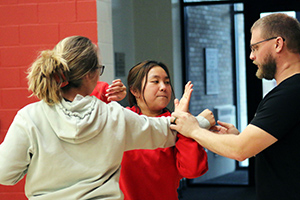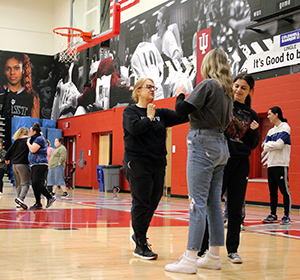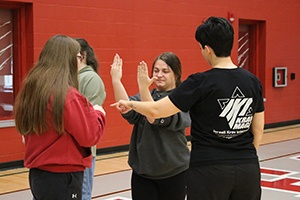One-day session provides valuable basic skills in self-defense for nursing students
Thirty-seven nursing students in the Nursing Research and Evidence Based Practice course exchanged their crimson scrubs for athletic shorts and tennis shoes for an afternoon session in self-defense training.
Instead of meeting in the classroom, the nursing students spread across the Student Events Center paired with a partner or a group to imitate self-defense techniques.
Instructor Aaron Olson of Israeli Krav International Krav Maga & Freestyle Kickboxing, and his training partner, Cait Clark, are certified trainers and led the training.
Olson said he hoped that the nursing students built confidence in the techniques shown to them, and that they feel more empowered in their ability to defend themselves.
“This style of self-defense is no-nonsense and straight to the point, we teach stopping the threat and fighting until you are safe,” Olson said.

Robin Brunk, assistant professor of nursing, has experienced violence in nursing and sought a form a self-defense that aligned with her philosophies. She found that with Krav Maga & Freestyle Kickboxing and is now working toward her orange belt.
She invited her instructor and training partner to help lead a self-defense training exercise for junior-level nursing majors in her Nursing Research and Evidence Based Practice course.
“The purpose of the self-defense training is to educate nursing students how to defend themselves or the patient in a violent situation and find a way of escape to safety or to get help,” Brunk said.
Healthcare providers have policies and procedures in place regarding violence in the workplace. The techniques shown to the nursing students are meant to stay within those policies.
“It is however very adaptable for physical limitations and to fit the scope of a job. With nursing students not being able to strike or harm a patient within reason, we are able to teach these techniques in a less aggressive way. Fitting their need better within the scope of their job,” Olson said.
Before the training exercise – and for all nursing classes – students complete a ticket to participate. For the self-defense class, students completed a response to a question asking them if they had witnessed or been the victim of violence in a healthcare setting.
Students also watched a 2021 American Nursing Association (ANA) video, “Silence No More, End Nurse Abuse,” as part of its campaign to end violence toward nurses. According to the ANA, one in four nurses has been physically assaulted and more than 70 percent have been harassed.
“Learning self-defense teaches the student not only how to protect themselves, but the self-defense also teaches the student how to protect their patient, which is the highest duty of a nurse,” Brunk said.

According to its website, Krav Maga is a defense combative system designed to be easy to learn, memorize and use. They specialize in using the least amount of various techniques while maintaining the highest level of effectiveness. Krav Maga specializes in defending against armed attackers, tight spaces and quick resolutions to confrontations. They emphasize situational awareness and avoidance to many situations but train to a level that conscious decision making can occur while actively defending so that appropriate response level is obtained.
Kathy Dang, a nursing major from Greenville, Ohio, is one of the students to learn self-defense for the first time because of the training exercise.
“I felt like I learned a lot during the self-defense training. Not only will I be able to use these techniques while in the healthcare setting but I can use these techniques in my daily life,” Dang said.
Students paired with each other and took the role of attacker and defender to practice the techniques taught by Olson and Clark. The instructors went group-to-group watching each perform the technique and helped them to perfect it. Brunk also helped to fine-tune their movements.
Dang said many of the lessons the instructors taught during the lesson will stay with her, especially the initial moves shown to students to ward off an attack.
“This is when the attacker throws a punch and we would raise both our arms up and sort of try to catch their punch and put them in an arm lock. This technique has stuck with me the most because usually hitting and punching are the initial reaction of a violent person,” Dang said. “I also think that it is important that we are aware that there will be more force that actually occurs when this situation arises than when we were training. So I think more training will help me feel more confident when defending myself.”
While nursing is known respected for its level of knowledge to practice, care of patients and dedication, people may not think about the types of dangers nurses face every day from patients or patient guests, including family members and friends.

Brunk has experienced nursing violence first hand.“It is real in the healthcare setting,” she said.
Olson said the Krav Maga is a self-defense style that anyone could find resourceful.
“This style isn’t about being a tough guy or anything like that. You don’t need to be strong, fast, or an athlete of any kind. This style was developed for the everyday person and designed to be easy to learn. I’ve worked with kids as young as 8 all the way to adults as old as 78, all of whom were able to do what we teach. We teach it’s okay to run away and that any confrontation you walk away from is a victory,” Olson said.
As for Dang, she feels the self-defense training is more than preparation for a career. “With much more training, I feel like I will be more confident in protecting myself when tension arises. I will also be able to teach other healthcare workers, friends, family, and others,” Dang said.
Dang added everyone could benefit from self-defense training.
“I think it is important that everyone, not just healthcare workers, be trained or have some knowledge of self-defense,” Dang said. “I also think that self-defense training should be implemented in every facility to ensure patient safety, your safety, and the safety of others around you.”

